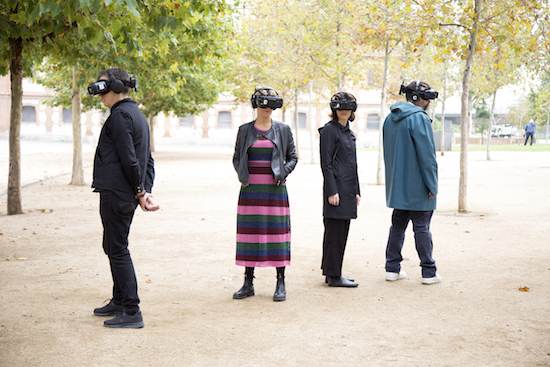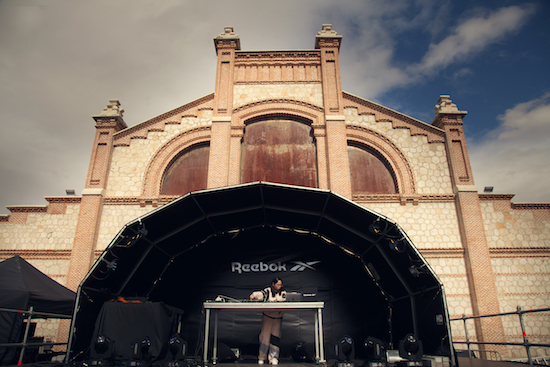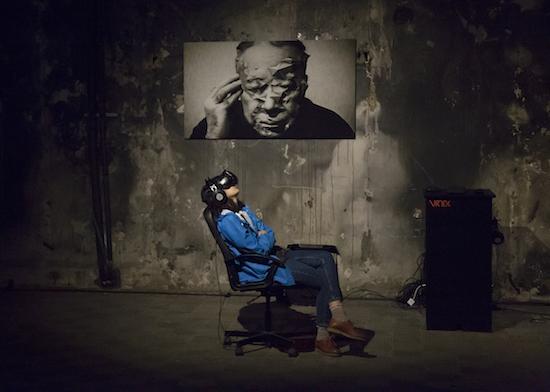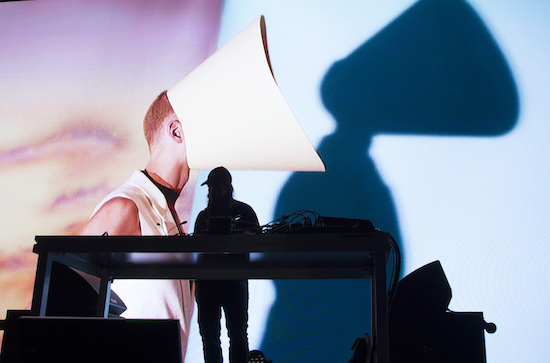Live shots by De la Puente foto espacio
“Let yourself be invaded,” coos a voice creepily into my ear. I’ve just downed a shot of blue liquid and am stumbling about the dark basement of an old abattoir. My hands float in front of me, scanning for obstacles. Or maybe that man who just told me to prepare for invasion. I’m trying to adjust to the total sensory deprivation; big headphones block out external noise and a virtual reality headset flashes blurry, digital images in front of my eyes.
“Inhale”, says the voice again, but a French accent makes it sound more like, “In hell.” I breathe, shuffle forward, my feet gingerly feeling out a staircase. I climb and the visuals in front of my eyeballs get brighter; a clue that I’m now outside, in sunshine. Peering forwards into my VR screen I see my own hands in front of me, my feet reassuringly still underneath. The voice continues gibbering softly in my ears. I look around the stone courtyard, relieved to recognise yellow patterned tiles I’d seen earlier, and above me, a bright, blue Spanish sky. But as I tilt my head to gaze up at fluffy Simpsons clouds, suddenly the image flips and although my face is pointing skywards, I’m seeing my feet again. Later psychedelic filters bleed into my view, turning the sky cyberpunk pink, or a wall seasick green. My sight will zoom in or out suddenly, controlled remotely as if fingers were pinching and sliding over a phone screen, making me want to flip the mask up for a reality check. Something soft but unrecognisable is placed in my hand (it turns out to be a rose petal) and I’m shown peaceful footage of a river, then a stack of freshly chopped tree trunks that I can almost smell as the view rotates sideways and rolls out of sight.
It’s all part of #ALPHALOOP, a disorientating ‘techno-shamanism’ project by the French artist Adelin Schweitzer. Groups are taken on a guided walk by ‘a humanist shaman’ playing a flute (the actor Fred Sechet), while external machines attached to their face distort their perceptions of what’s real. It’s one of many trippy Matrix moments during L.E.V festival, where simulations of reality and ultra-modern technology merge with live music over four days in Madrid.
The Visual Electronics Laboratory (Laboratorio de Electrónica Visual, or L.E.V for short) began thirteen years ago in Gijón in north Spain, exploring the overlaps between visual art and electronic sound. Previous festivals have featured Aphex Twin, Oneohtrix Point Never, Lotic, Andy Stott, PYE Corner Audio, Gazelle Twin and Factory Floor amongst other acts, and this year was the first time L.E.V moved to Madrid, taking over Matadero, a big contemporary arts space in a former slaughterhouse in the south of the city.

After slipping on an electronic wristband charged up with cash to be tapped in exchange for alcohol free beers or vermouth at the bar, the first night begins with a reminder of early, lo-tech experiments into altered perceptions, a cardboard pair of 3D glasses. Composer and audio-visual artist Maxime Corbeil-Perron’s jagged projections of grids and flashing lines poke out into the auditorium in time with his industrial electronic score before we move next door for a live show by Canadian artists Push 1 Stop (Cadie Desbiens-Desmeules) and Wiklow (Michael Dean). Dry ice hisses into the dark room and white shapes strobe through the air, pulsing and oscillating around the crowd. Sharp scribbles synchronise with their minimal dance music, swelling into huge circles of light above our heads, an impressive monochrome take on Robin Fox’s rainbow laser projections that do a good job of placing us inside the invisible sound frequencies, with lines rippling and vibrating, sketching out the music in space.
Day two features James Ferraro’s Requiem For Recycled Earth, the first of his Four Parts Of Mirai, "a post-apocalyptic narrative" about the decline of civilisation. It’s less terrifying than it sounds on paper (or more likely, a digital screen); a gentle, melancholic score with live flute accompaniment, where the former Skater’s wavy hairdo is silhouetted against rippling turquoise visuals by Maotik, and Ferraro’s fun, hypnagogic jams of old are replaced by more serious, meditative computer ballads with bursts of crashing drums.
Matadero’s powerful, immersive Soundscape sound system ricochets Ryoichi Kurokawa’s set around the 4D speakers in the cavernous room, like an airplane whooshing round a hangar as he machine guns IDM beats into the audience, who are still holding back from properly dancing at this point on the Friday night. London artist Djrum, real name Felix Manuel, aids in the process of them loosening up with the help of a stage dancer; a 90s throwback in a bikini and ankle length fake fur coat, throwing her arms euphorically in the air for his bouncy, shimmery house beats.
Mystical, enigmatic party starter Aïsha Devi brings impish thrills to her excellent set of thumping rave beats, ramping up the BPMs then pulling them right back, playing with the crowd through control and release. At one of the more banging highs of her set, with Devi writhing and swaying over her table of electronic gear, one Spanish dancer screams “más rápido!”, totally sucked in by her teasing style and begging her to go full pelt for a bit longer.

Dressed in a pastel peach and grey Reebok tracksuit, Sara Abdel-Hamid aka Ikonika’s outdoor set gets people vaping, smoking and dancing in the cool Autumn sunshine, sipping beers as she drops Ariana Grande’s ‘Touch My Body’ into her hour of dubstep and bright, glitchy souped up pop.
Mr Mitch is less lucky with the weather; the UK grime producer is just arriving on stage when a downpour starts, luckily the crowd is up for his emo mutations on dance music, staying under umbrellas for a while to dance to his loved up laments for clubbers. Indoors, Sega Bodega refuses to stick to one style with chirpy, ravey ditties morphing into grandiose, swooning melodies or Europop style blasts, played from inside a square of see through plastic curtains. Having brought the crowd’s energy levels right up, it seems like a missed opportunity when Emptyset then play a meandering, unfulfilling slow burner of a set, not really gathering momentum despite it being after midnight on a Saturday.
Before Sunday’s gentle wind down of live music, there is time to play around in the virtual reality cinema Nave O, a massive shadowy room with stone pillars and a chequered black and white floor. Einstürzende Neubaten have written the score for Das Totale Tanz Theater 360, a futuristic, animated music video to mark this year’s Bauhaus centenary, where dancers in silver bodysocks pirouette artfully to choreography by Richard Siegal. Playing around with the Bauhaus idea of theatre summarised in the L.E.V programme as “theatre that would liberate its audiences from their passivity and place them at the centre of the action in an imaginary world”, the six minute clip lets you tilt your head down to see dancers gracefully hula hooping with robot masks on underneath you, or look up at dancers on floating discs in a giant circus tent.
Ghost In The Shell: Virtual Reality Diver is a VR update on the 1980s manga, with slick sci-fi visuals of female action hero Motoko Kusanagi getting caught in time loops and digital portholes, but with that kind of Lara Croft style and macho blockbuster aesthetic that seems dreamt up by someone who would maybe order a subservient virtual girlfriend online, like in that episode of Black Mirror.

Emergence is much more fun, an interactive game by UK artist Matt Pyke where you direct a character through a sea of clone-like bodies, leading the avatar speck towards shafts of light, each one levelling you up to another state, either underwater, floating in space or standing in the middle of a worshipping crowd, gathered eerily around you in a circle.
VR’s powerful potential for both good and evil is obvious in Nave O, where one video (The Lacuna Shifts) give you a claustrophobic, sensory exploration of tunnelling through tight coffin-like spaces, before widening out to let you gaze on wide floors and curved walls with nauseating Alice in Wonderland style altering of proportions and spaces. Cocotte Minute, meanwhile, gives the player a totally undisturbing and playful tour around a magician’s living room with an interactive gramophone, cocktail bar and astrological star map, and Your Spiritual Temple Sucks drew the viewer into a 360° Taiwanese video game, where your moral torpor and dissatisfied wife became part of the interactive, tongue in cheek storyline.
Closing the festival with live A/V sets from Kelly Moran and Alessandro Cortini – who serenade the tired Sunday night crowd lying in deckchairs with eyes closed – it is a mellow finish to a visually spectacular, very high spec programme, that peers into the outer limits of technology’s ability to enhance live gig and art experiences. What sensory realities can we adjust to, and what norms have we grown used to, L.E.V seems to be asking with certain shows. Are our senses as finely tuned in to music and visuals as they could be? And what narrow filters or sophisticated digital enhancers are shaping our hyper-individual views of the world?
In a city where a Franco-themed bar sits five minutes up the road from Matadero (run by a Chinese immigrant who has named his son after the former Spanish dictator) and the green flags of the far right party Vox are waved nonchalantly in the streets, L.E.V seems to offer escapes from certain terrifying realities, into less concrete realms, where artificial intelligence, virtual reality and audio visual art offer bendy portholes into new, hallucinogenic, entertaining, unsettling, sometimes cold, but also occasionally more empathetic dimensions.


